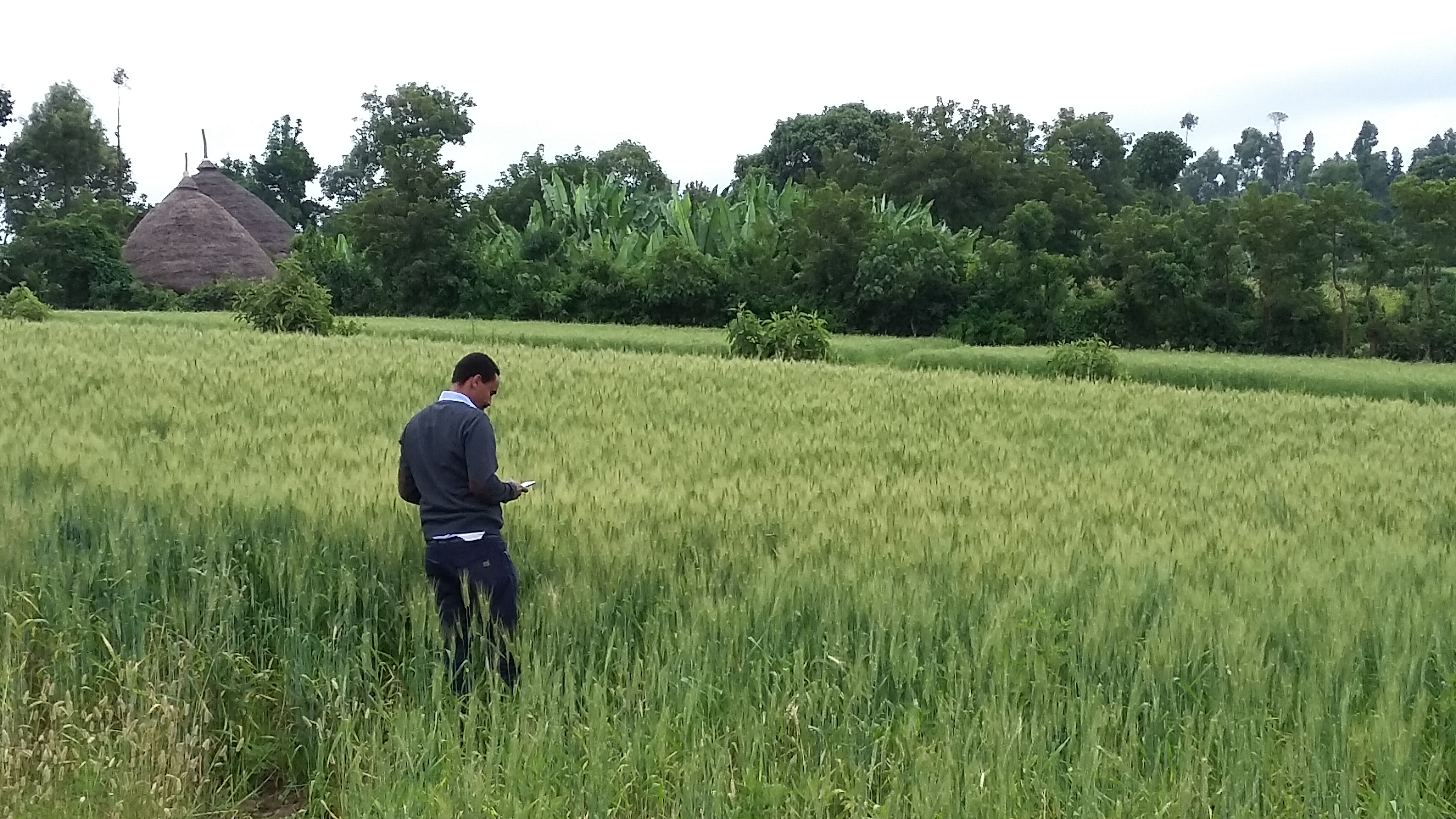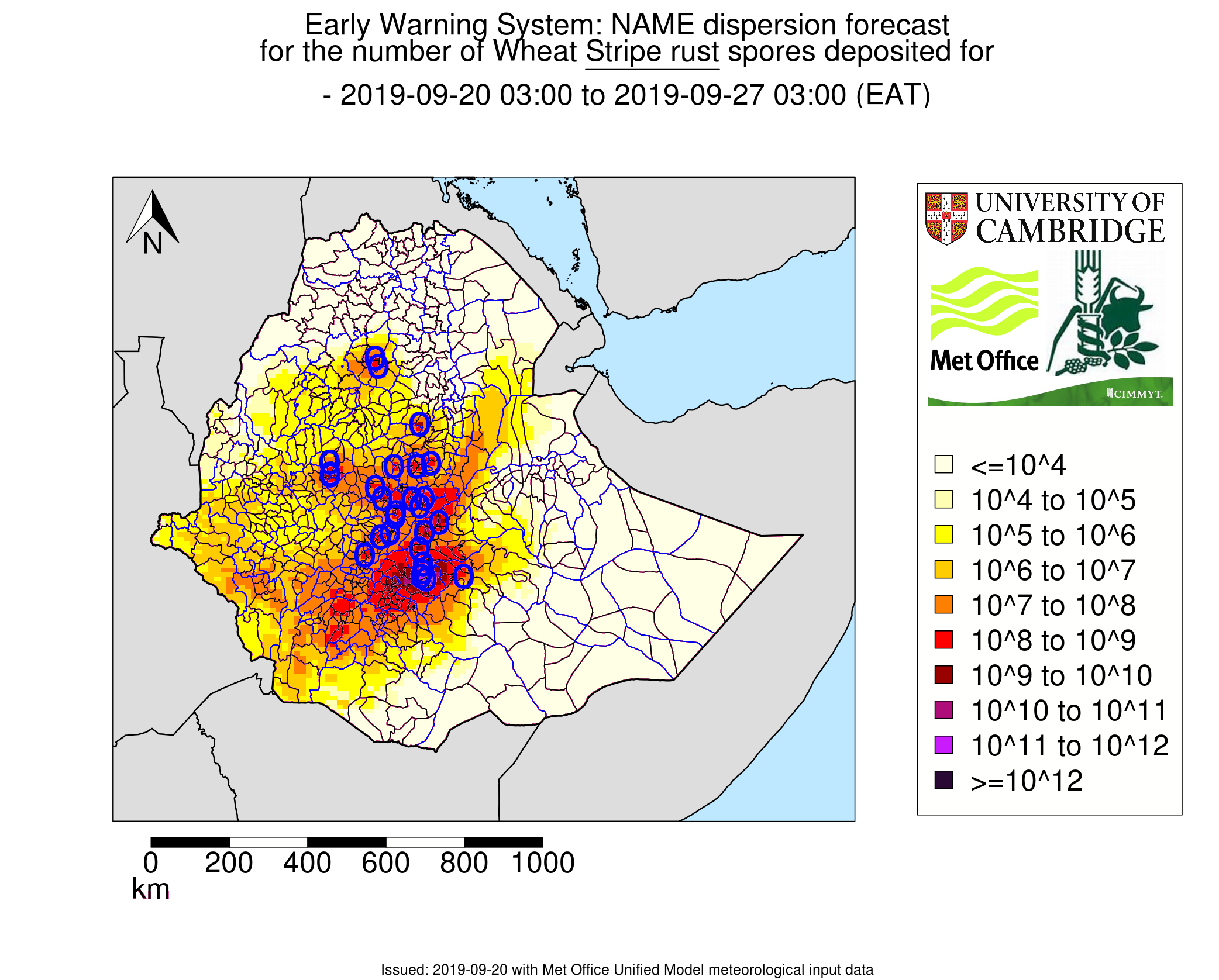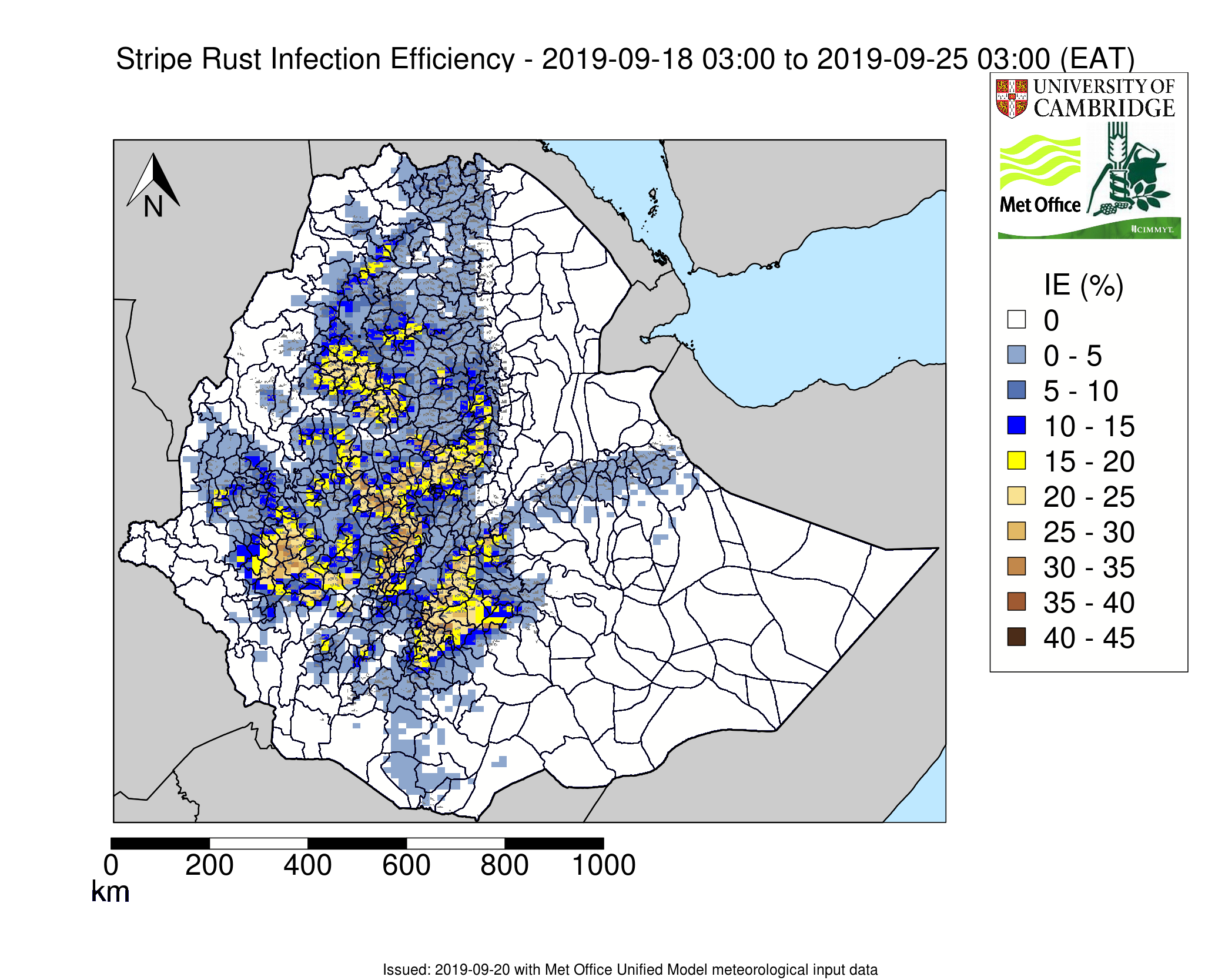Texcoco, Mexico
November 4, 2019

One of the researchers behind the study, Yoseph Alemayehu, carries out a field survey in Ethiopia by mobile phone. (Photo Dave Hodson/CIMMYT)
Using field and mobile phone surveillance data together with forecasts for spore dispersal and environmental suitability for disease, an international team of scientists has developed an early warning system which can predict wheat rust diseases in Ethiopia. The cross-disciplinary project draws on expertise from biology, meteorology, agronomy, computer science and telecommunications.
Reported this week in Environmental Research Letters, the new early warning system, the first of its kind to be implemented in a developing country, will allow policy makers and farmers all over Ethiopia to gauge the current situation and forecast wheat rust up to a week in advance.
The system was developed by the University of Cambridge, the UK Met Office, the Ethiopian Institute of Agricultural Research (EIAR), the Ethiopian Agricultural Transformation Agency (ATA) and the International Maize and Wheat Improvement Center (CIMMYT). It works by taking near real-time information from wheat rust surveys carried out by EIAR, regional research centers and CIMMYT using a smartphone app called Open Data Kit (ODK).
This is complemented by crowd-sourced information from the ATA-managed Farmers’ Hotline. The University of Cambridge and the UK Met Office then provide automated 7-day advance forecast models for wheat rust spore dispersal and environmental suitability based on disease presence.
All of this information is fed into an early warning unit that receives updates automatically on a daily basis. An advisory report is sent out every week to development agents and national authorities. The information also gets passed on to researchers and farmers.

Example of weekly stripe rust spore deposition based on dispersal forecasts. Darker colors represent higher predicted number of spores deposited. (Graphic: University of Cambridge/UK Met Office)
Timely alerts
“If there’s a high risk of wheat rust developing, farmers will get a targeted SMS text alert from the Farmers’ Hotline. This gives the farmer about three weeks to take action,” explained Dave Hodson, principal scientist with CIMMYT and co-author of the research study. The Farmers’ Hotline now has over four million registered farmers and extension agents, enabling rapid information dissemination throughout Ethiopia.
Ethiopia is the largest wheat producer in sub-Saharan Africa but the country still spends in excess of $600 million annually on wheat imports. More can be grown at home and the Ethiopian government has targeted to achieve wheat self-sufficiency by 2023.
“Rust diseases are a grave threat to wheat production in Ethiopia. The timely information from this new system will help us protect farmers’ yields, and reach our goal of wheat self-sufficiency,” said EIAR Director Mandefro Nigussie.
Wheat rusts are fungal diseases that can be dispersed by wind over long distances, quickly causing devastating epidemics which can dramatically reduce wheat yields. Just one outbreak in 2010 affected 30% of Ethiopia’s wheat growing area and reduced production by 15-20%.
The pathogens that cause rust diseases are continually evolving and changing over time, making them difficult to control. “New strains of wheat rust are appearing all the time — a bit like the flu virus,” explained Hodson.
In the absence of resistant varieties, one solution to wheat rust is to apply fungicide, but the Ethiopian government has limited supplies. The early warning system will help to prioritize areas at highest risk of the disease, so that the allocation of fungicides can be optimized.

Example of weekly stripe rust environmental suitability forecast. Yellow to Brown show the areas predicted to be most suitable for stripe rust infection. (Graphic: University of Cambridge/UK Met Office)
The cream of the crop
The early warning system puts Ethiopia at the forefront of early warning systems for wheat rust. “Nowhere else in the world really has this type of system. It’s fantastic that Ethiopia is leading the way on this,” said Hodson. “It’s world-class science from the UK being applied to real-world problems.”
“This is an ideal example of how it is possible to integrate fundamental research in modelling from epidemiology and meteorology with field-based observation of disease to produce an early warning system for a major crop,” said Christopher Gilligan, head of the Epidemiology and Modelling Group at the University of Cambridge and a co-author of the paper, adding that the approach could be adopted in other countries and for other crops.
“The development of the early warning system was successful because of the great collaborative spirit between all the project partners,” said article co-author Clare Sader-Allen, currently a regional climate modeller at the British Antarctic Survey.
“Clear communication was vital for bringing together the expertise from a diversity of subjects to deliver a common goal: to produce a wheat rust forecast relevant for both policy makers and farmers alike.”
RELATED PUBLICATIONS:
An early warning system to predict and mitigate wheat rust diseases in Ethiopia
https://doi.org/10.1088/1748-9326/ab4034
ACKNOWLEDGEMENTS:
This study was made possible through the support provided by the BBSRC GCRF Foundation Awards for Global Agriculture and Food Systems Research, which brings top class UK science to developing countries, the Delivering Genetic Gains in Wheat (DGGW) Project managed by Cornell University and funded by the Bill & Melinda Gates Foundation and the UK Department for International Development (DFID). The Government of Ethiopia also provided direct support into the early warning system. This research is supported by CGIAR Fund Donors.
ABOUT CIMMYT:
The International Maize and Wheat Improvement Center (CIMMYT) is the global leader in publicly-funded maize and wheat research and related farming systems. Headquartered near Mexico City, CIMMYT works with hundreds of partners throughout the developing world to sustainably increase the productivity of maize and wheat cropping systems, thus improving global food security and reducing poverty. CIMMYT is a member of the CGIAR System and leads the CGIAR Research Programs on Maize and Wheat and the Excellence in Breeding Platform. The Center receives support from national governments, foundations, development banks and other public and private agencies. For more information, visit www.cimmyt.org.
ABOUT THE ETHIOPIAN INSTITUTE OF AGRICULTURAL RESEARCH (EIAR):
The Ethiopian Institute of Agricultural Research (EIAR) is one of the oldest and largest agricultural research institutes in Africa, with roots in the Ethiopian Agricultural Research System (EARS), founded in the late 1940s. EIAR’s objectives are: (1) to generate, develop and adapt agricultural technologies that focus on the needs of the overall agricultural development and its beneficiaries; (2) to coordinate technically the research activities of Ethiopian Agricultural Research System; (3) build up a research capacity and establish a system that will make agricultural research efficient, effective and based on development needs; and (4) popularize agricultural research results. EIAR’s vision is to see improved livelihood of all Ethiopians engaged in agriculture, agro-pastoralism and pastoralism through market competitive agricultural technologies.